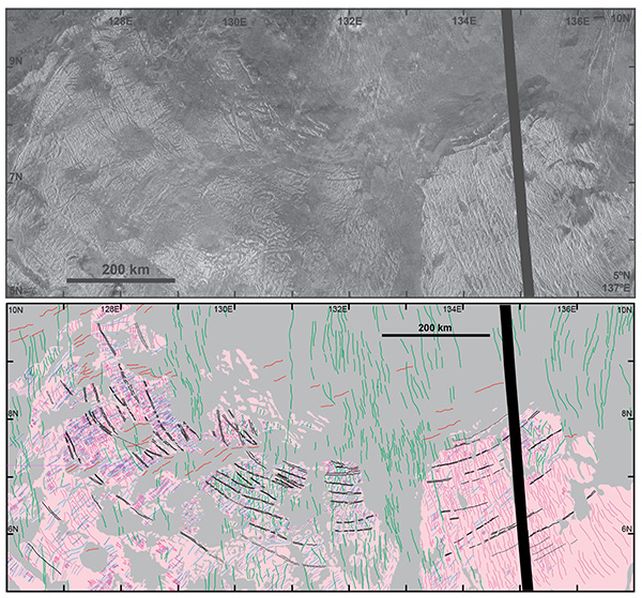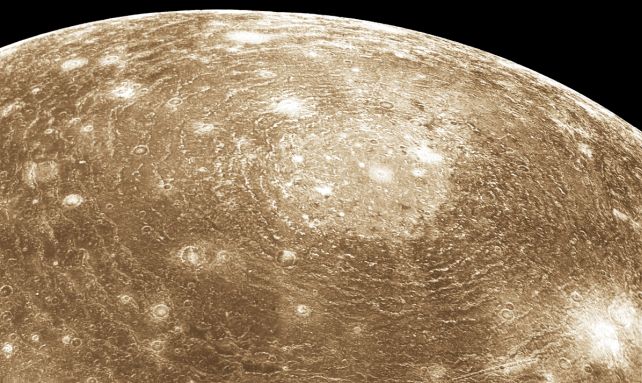Early in the solar system’s existence, things were much more violent than they are today. Rocks flew everywhere, willy-nilly, crashing into the newly formed planets, littering them with craters and gouging out impact basins.
Mercury, Mars and the Moon are all heavily drawn. Even Earth – where geological and weathering processes quickly erode most evidence – shows signs of gigantic impacts.
But there is something very strange about Venus.
Although the infernal world has beautifully preserved impact craters on its surface, scientists could find no evidence of craters more than 300 kilometers (186 miles) in diameter, known as impact basins.
Now that evidence has emerged. It just doesn’t look the way we expected — which could give us new clues about the formation and evolution of Venus when the solar system was young.
That evidence is a feature known as tessera terrain; a series of concentric rings on the surface of Venus, about 1,500 kilometers wide. New analysis suggests that Venus’s Haste-Baad Tessera was the result of two giant impacts, one right after the other, with a planet still soft and molten under a thin crust, about 3.5 billion years ago.
“If this really is an impact structure, it would be the oldest and largest on Venus, giving us a rare glimpse into Venus’s past and information about early planetary processes,” said geologist Vicki Hansen of the Planetary Science Institute.
‘And perhaps even more importantly: it shows us that not all impact structures are alike. Impact structures are the result of a bolide – a body of unspecified composition – colliding with a target planet. The nature of the car is important, but so is the nature of the target.”

When the rocky planets were newly formed, they were much warmer inside than they are today, with their molten interiors taking up a larger portion of their volume under a much thinner crust. Hansen and her colleagues conducted modeling analyzes to study the formation processes that could have produced the Haastte-Baad Tessera, and determined that a double impact was the most plausible scenario.
Two impactors, back to back, would have smashed straight through the 10 kilometer thin crust on Venus’ surface and into the molten mantle below. Magma would have bubbled to the surface and the surrounding surface was crumpled, forming the concentric tessera pattern.
We know this process can happen because we have seen it elsewhere in the solar system. On Jupiter’s moon Callisto there is a multi-ring structure about 3,800 kilometers in diameter. This is Valhalla, the largest known multi-ring impact structure in the system, and scientists think it was formed when something large collided with the icy moon. Frigid water flowed from below to fill the hole, and the impact deformed the surrounding crust.
A potential problem with that model is that tessera terrain is sometimes found on a plateau. That’s not the case for Haaste-Baad, but the model should include plateau settings; if an impact cannot produce a tessera plateau, something else should be responsible for the ring structures.
“This is where it gets fun,” Hansen explains.
“When you have huge amounts of partial melt in the mantle rushing to the surface, something is left behind called residue. Solid residue is much stronger than the adjacent mantle, which did not undergo partial melting. What may be surprising is that it solid residue also has a lower density than the entire mantle around it. So it’s stronger, but also buoyant. You basically have an air mattress in the mantle under your lava pond, and it will just rise and raise that tessera.”

If the lava remains in place, it will harden in that raised position. When it flows away, the height of the terrain drops, as we see at Haastte-Baad.
The modeling suggests that the impactors that produced the terrain were quite large, about 75 kilometers in diameter. This appears to have been a fairly rare event in the solar system, but not unheard of; there are geological features on Earth that may have formed in the same way, such as a dike swarm at Lake Victoria in Africa.
“Who would have thought that flat, low-lying tessera terrain or a large plateau could be an impact crater on Venus?” says Hansen.
‘We were looking for big holes in the ground, but for that you need a thick lithosphere, and early Venus didn’t have that. Mars had a thick lithosphere. The moon had a thick lithosphere. Earth probably had a thick lithosphere. thin lithosphere when it was also young, but its record has been greatly altered or erased by erosion and plate tectonics.
The research has been published in the Journal of Geophysical Research: Planets.



